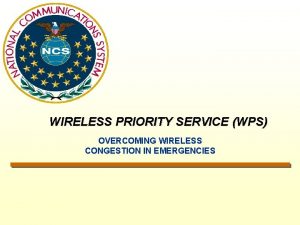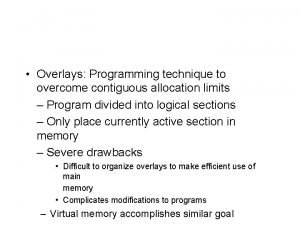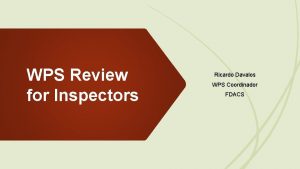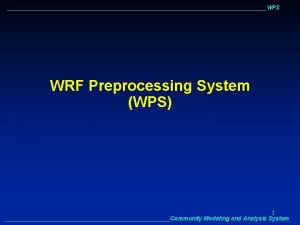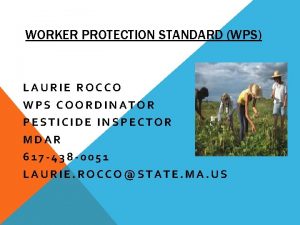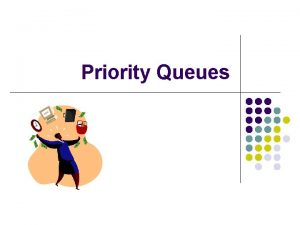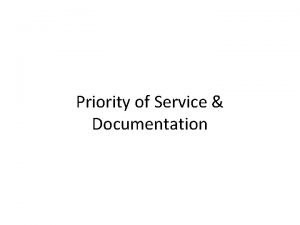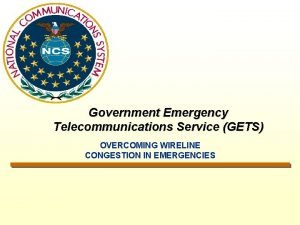WIRELESS PRIORITY SERVICE WPS OVERCOMING WIRELESS CONGESTION IN















- Slides: 15

WIRELESS PRIORITY SERVICE (WPS) OVERCOMING WIRELESS CONGESTION IN EMERGENCIES

Outline • The Issue – Congestion • What is WPS? • Why do you need WPS? • How do you use WPS? • How much does WPS cost? • Who is eligible for WPS? • How do you order WPS? • Satellite backup • Contact information 2

The FUNDAMENTAL Issue: Network Congestion, at one of many points, can block a call ! Local Exchange Networks AT&T MCI SPRINT Local Exchange Networks Mobile Switch Government Emergency Telecommunications Service addresses wireline congestion Wireless Priority Service addresses wireless congestion at call origination and call termination 3

The GETS Calling Card Calling cards are in widespread use and easily understood by the NS/EP User, simplifying GETS usage 0123 4567 8910 Disaster Response Team #1 GETS priority is invoked “call-by-call” US CITY EOC GETS is a "ubiquitous" service in the Public Switched Telephone Network…if you can get a DIAL TONE, you can make a GETS call 4

What is WPS? • An enhancement to basic wireless service that allows your National Security/Emergency Preparedness (NS/EP) calls to queue for priority service in order to complete the call • Together with GETS, WPS dramatically improves “end-to-end” call completion during emergencies 5

Why Do You Need WPS? • Disasters, terrorist attacks, and major accidents trigger tremendous telephone traffic in the landline and wireless networks • NS/EP personnel at all levels of government compete with the public for these congested landline and wireless resources • GETS provides the means to get your landline call through • WPS provides the means to get your wireless call through 6

Nationwide WPS Program • Currently Global System for Mobile (GSM) communications carriers only • Available nationwide in most, if not all of the service areas • Cingular (and formerly AT&T Wireless) • Sprint Nextel • T-Mobile • See “Carriers” on the WPS website for specific coverage • Code Division Multiple Access (CDMA) carriers • WPS is expected to be available from both nationwide CDMA -based carriers. • Verizon Wireless began rolling out WPS 2 nd Qtr. 2006. In areas where Verizon Wireless has not yet implemented WPS, users can pre-subscribe to Verizon Wireless. • Sprint PCS is anticipated in 2007. 7

How Do You Use WPS? • When you need to make an official call, and you encounter congestion, simply retry your call but prefix your dialed number with *272 – e. g. *272 703 -555 -1234 • Everything else is automatic – your call will queue for up to 30 seconds and “grab” the next available path • If landline networks are also congested, utilize *272 plus the GETS access number to get priority in both wireless and landline networks 8

How Much Does WPS Cost? • WPS feature subscription rate: • $10 maximum one-time activation fee • $4. 50 maximum monthly service fee • $. 75 per minute maximum for WPS calls (*272) • WPS minutes are not charged against your basic service • These charges represent the maximum amounts charged by the cellular carrier and may be lower; contact your carrier for current rates • WPS charges are in addition to your commercial plan charges 9

Guidance on User Eligibility • Persons in NS/EP leadership positions and key staff • Applicable at all levels: Federal, State, and Local User Category Examples Executive Leadership/Policy President, Governors, Lt Governors, Makers City/County leaders, Cabinet officers, key senior staff Disaster Response / Military Command & Control Continuity of government and national security leadership; Emergency Operations Center (EOC) coordinators/directors Public Health, Safety, Law Enforcement Senior command levels of law enforcement, fire and public safety functions Public Services / Utilities and Public Welfare Corp Of Engineers leadership; Water/sewage/ telecomm/transportation leadership Disaster Recovery Medical resources; sheltering; infrastructure damage assessment; Disaster Field Office (DFO) 10

Typical WPS User Functions • Managing the initial response to an emergency at the local, state, regional and federal levels • Leadership of departments and agencies including key support staff • Insuring reconstruction of the basic infrastructure • Essential Continuity of Government (COG) and national security functions • Operations critical to life, property, and maintenance of law and order immediately after an event • Managing public works, utility infrastructure damage assessment, restoration efforts and transportation to accomplish emergency response activities • Managing medical resources • Managing a variety of recovery operations after the initial response • Establishing and sustaining shelters • Obtaining detailed damage assessments 11

Typical WPS Users • President, Governor, Mayor, County Executive • Cabinet Secretary at Federal or State Level • Chief of Staff – Military or Civilian • Emergency Management Director • Chief of Police, Fire Chief • Director of Emergency Medical Services • Chief Operating Officer of a Public Utility • Director, Incident Command Center • Key Staff of the above users • Key operating locations 12

How Do You Order WPS? • Your organization Point of Contact (POC) applies for WPS for all users within organization • WPS website: wps. ncs. gov • Telephone: 866 -NCS-CALL, Select Option 2 for WPS • Upon WPS approval, POC forwards carrier account activation information to NCS • NCS orders WPS feature added to user’s basic service • If user does not already have carrier service, user acquires basic commercial service 13

Satellite Backup • Satellite phones provide additional backup when cellular service is not available for any reason • Good example: extended power outages can make office private branch exchanges (PBXs) inoperable, and outages that last for more than several hours can exhaust backup power supplies at cell towers • Carriers include Globalstar, Iridium, Inmarsat, etc. • Can be utilized as handheld mobile sets, in vehicles with mobile or fixed installations, and in structures with fixed antenna units. 14

WPS Contact Information MAILING ADDRESS: NCS (N 2) P. O. Box 4502 Arlington, VA 22204 -4502 WEBSITES: TELEPHONE: Information/Sign-Up • 1 -866 -NCS-CALL (Option 2 for WPS) Trouble Reporting (24 x 7) • 1 -800 -818 -4387 E-MAIL: http: //wps. ncs. gov wps@dhs. gov 15
 Wireless priority services
Wireless priority services Pincuegula
Pincuegula Priority mail vs priority mail express
Priority mail vs priority mail express Burman's priority list gives priority to
Burman's priority list gives priority to Overcoming hindrances to spiritual development
Overcoming hindrances to spiritual development Dram refresh failure
Dram refresh failure Writing a narrative about overcoming a challenge
Writing a narrative about overcoming a challenge Scripture about overcoming adversity
Scripture about overcoming adversity All the blocks you want
All the blocks you want Coalescing holes in operating system
Coalescing holes in operating system Knowledge2practice
Knowledge2practice Overcoming communication barriers in pharmacy
Overcoming communication barriers in pharmacy Overcoming perfectionism roz shafran
Overcoming perfectionism roz shafran Overcoming the dark side of leadership
Overcoming the dark side of leadership Overcoming the monster examples
Overcoming the monster examples Overcoming trials and temptations
Overcoming trials and temptations
